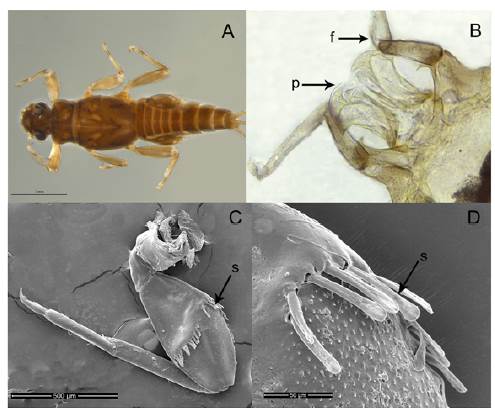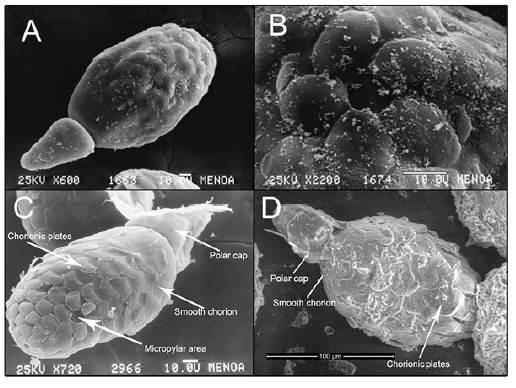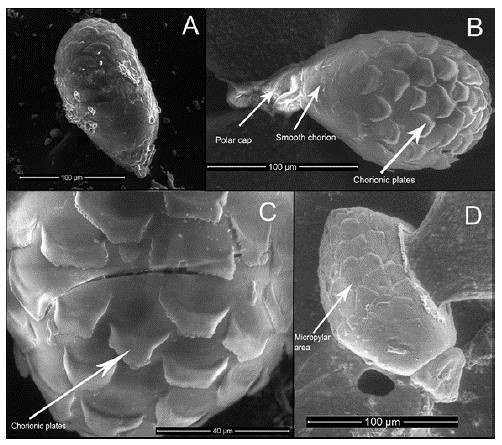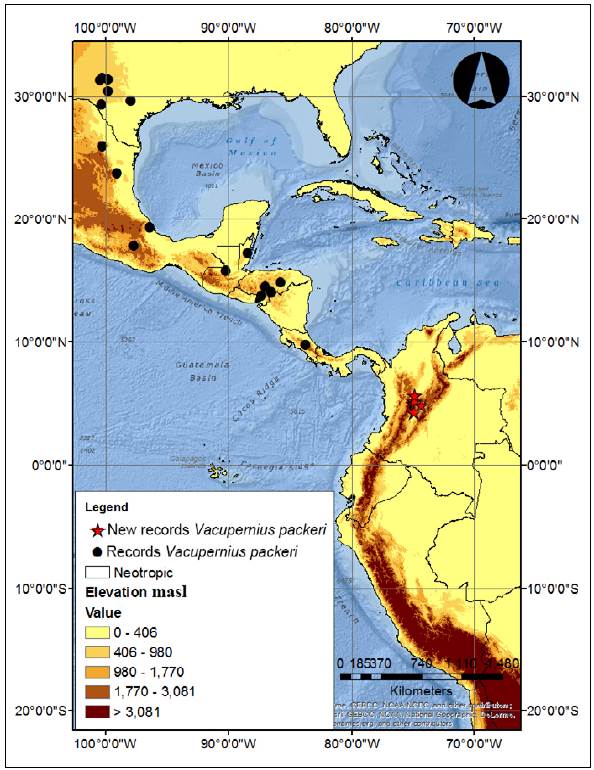Introduction
The genus Vacupernius was proposed by Wiersema & McCafferty (2000) to include the following species: V. packeri (Allen), V. paraguttatus (Allen), and V. rolstoni (Allen), which were originally described by Allen (1967) in Leptohyphes Eaton. According to the key proposed by Wiersema & McCafferty (2000), Vacupernius can be distinguished from Leptohyphes and the other genera of Leptohyphidae by a combination of characters in nymphs: Middle and hind tibiae without medial longitudinal row of branched setae on the dorsal region; hind tarsi approximately half of the length of the respective tibiae, and spatulate setae in the transverse row at mid-length of fore femora. Adults can be differentiated by male genitalia with three-segmented forceps mounted on elevated columnar bases acutely pointed, penes almost completely fused with a unique morphology, and mid- and hind tarsi slightly less than one-half the length of the respective tibiae.
Among the three species of the genus, V. packeri has the widest distribution (Belize, Costa Rica, Guatemala, Honduras, México, and the USA) and has not been registered at more than 900 MASL while V. paraguttatus is reported in the United States and V. rolstoni in the Dominican Republic (Wiersema & McCafferty, 2000). It should be noted that Emmerich (2004) first recorded the genus in South America but could not identify the species because the captured individual was a subimago and the morphology of the genitals was not clearly visible. In that study, the author observed that the penis and the styliger plate of Vacupernius were like those of Traverhyphes, Allenhyphes, and Yaurina, but this has not been phylogenetically evaluated yet. To expand the knowledge on Vacupernius, in this study, we recorded for the first time a species in Colombia and South America identified based on adults and nymphs. Additionally, we described for the first time the egg of this species and the genus.
Materials and methods
The nymphs, subimagos, and adults of V. packeri were collected in the departments of Tolima and Caldas (Colombia). The nymphs were collected qualitatively with manual nets and adults with light traps between 6:00 p.m. and 8:30 p.m. Some adult specimens were manually captured in spider webs in riparian vegetation.
Mouthparts, legs (nymphs), and genitalia (imagos) were mounted and analyzed by stereomicroscope. We used taxonomic keys and original descriptions (Allen, 1967; Wiersema & McCafferty, 2000) for species identification while eggs were described using the terminology proposed by Koss & Edmunds (1974). The collected material was stored in alcohol 96% and deposited at the Colección Entomológica del Programa de Biología de la Universidad de Caldas - CEBUC.
Pictures were taken using a Leica M205C stereomicroscope with an attached Leica MC-170HD camera. Some characters were examined through Scanning Electron Microscope (SEM) with a QUANTA 250 (11 kV) at low vacuum except those in figure 1C-D, which were washed with a neutral soap, ultrasonicated (for further cleaning), dehydrated, gold-coated, and then observed under high vacuum at the Instituto de Investigaciones en Estratigrafía (Universidad de Caldas). The map of species distribution was done in a digital elevation model of the Neotropic with the software ESRI® ArcMap 10.0 using the records published in the literature (Allen, 1967; Kilgore & Allen, 1973; Henry, 1986; Allen, 1978; Wiersema & McCafferty, 2000; Emmerich, 2004) and the new records of this study.
Results and discussion
The nymphs and adults collected corresponded to the species V. packeri (Allen) (Figure 1A), which was originally registered for Belize, Costa Rica, Guatemala, Honduras, México, and the United States (Allen, 1967; Kilgore & Allen, 1973; Henry, 1986; Allen, 1978; Wiersema & McCafferty, 2000) and now it is documented for the first time in the northern part of South America. The characters used in the determination of the species were the shape of the forceps and penis of the imagos (Figure 1B). Figure 1C-D shows the transversal row of the spatulate setae in the middle region of the fore femur in nymphs.

Figure 1 Vacupernius packeri: A. Nymph dorsal view. B. Detail of an adult male genitalia. C. Nymph fore leg. D. Detail of the spatulate setae in the fore femora. f: forceps. p: penis; s: setae
Description of the eggs
The eggs were extracted from female mature nymphs (Figure 2A) and female subimago (Figures 2 B-D). The following features were observed: Yellowish coloration pattern, 135152 um length, 80-95 um width (n=2), oval shape, one polar cap, chorionic plates slightly overlapped and absent near the polar capsule, and circular micropylar area surrounded by six chorionic plates located at the equatorial region of the egg.
Brittain (1982) reported that the spermatogenesis and oogenesis in Ephemeroptera are completed in the final nymphal instar and the eggs and sperm are physiologically mature in the subimago. Here we underline the importance of oology as a promising tool for associating Ephemeroptera nymphs and adults since the eggs from V. packeri nymphs, subimagos, and imagos had the same form and similar chorionic ornamentation as proposed by Domínguez & Cuezzo (2002) for other Ephemeroptera taxa. Concerning the contribution of the description of the eggs to the systematic relationship of Vacupernius, we observed that the species and the genus share similar oological characteristics to those of the Traverhyphes group (composed by Allenhyphes, Lumahyphes, Traverhyphes, and Yaurina), such as chorionic plates slightly overlapped and absent on the chorion surrounding of the polar cap (Figure 3). On the other hand, the study also allowed us to corroborate the observations of Emmerich (2004) regarding the affinities found in the shape of the penis and the styliger plate of Vacupernius and the Traverhyphes group.

Figure 3 Traverhyphes eggs. A, B. Traverhyphes (Mocoihyphes) edmundsi (modified from Molineri, 2004). C. Traverhyphes indicator (modified from Molineri, 2006). D. Traverhyphes sp
Despite the affinities between Vacupernius and Traverhyphes, they can be differentiated by the styliger plate with posterolateral projections and slender penes with spines in Traverhyphes while in the Vacupernius genus the styliger plate has no projection and the penes are broad (Domínguez, et al., 2006). Future phylogenetic analyses would be important to clarify the relationships between Vacupernius and the Traverhyphes group and their possible synonymization.
Regarding the ecology of the genus, the information is preliminary. The nymphs sampled in this study were found in low altitudes in the tropical dry forest region. The Norcasia and Armero-Guayabal municipalities in Colombia (Figure 4) where the species was found are located in the Magdalena River median and low regions, an interesting bio-geographical region similar to the Chocó region as suggested by Hernández-Camacho, et al. (2007).
Examined material
26 nymphs, 1 male imago, and 1 female imago (in spider web), Colombia, Tolima, Universidad del Tolima farm, Santo Domingo Stream, Armero-Guayabal, 5° 0' 18.1"N, 74° 54' 24.7"W, 120 MASL, 18/iii/2017, Dias, Bacca & Marulanda cols.; 1 nymph, Colombia, Tolima, Universidad del Tolima farm, Santo Domingo Stream, Armero-Guayabal, 5° 0' 18.1"N, 74° 54' 24.7"W, 120 m, 18/x/2015, Dias & Marulanda cols.; 2 female subimagos (eggs extracted from one of these subimagos), Colombia, Tolima, Universidad del Tolima Farm, Armero-Guayabal 5° 0' 18.1"N, 74° 54' 24.7"W, 120 MASL, 22/iii/2017, Dias, Bacca & Marulanda. col.; 1 nymph Colombia, Tolima, Cajamarca, Coello Stream, 4° 16' 57.8"N, 74° 53' 50.1"W, 327 MASL, 1/iv/2013, Meza, Llano & Benavides cols.; 1 nymph, Colombia, Tolima, Lumbi Stream, Mariquita, 5° 9' 21.4"N, 74° 53' 58.3"W, 120 MASL, 28/v/2017, Dias, Bacca & Marulanda cols.; 3 mature nymphs (eggs were extracted from two of them; two eggs were measured), Colombia, Caldas, Norcasia, Reserva Natural de Río Manso, Rio Manso Stream, 5° 39' 25.8"N, 74° 51' 44.6"W, 611 MASL, 21/xi/2014, Cardenas & Dias cols.

















